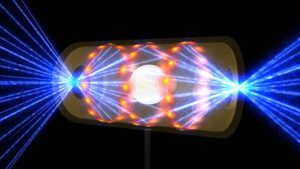
Researchers at the National Ignition Facility (NIF) in Livermore, California have reproduced a crucial fusion ignition experiment that saw more energy produced from a hydrogen fusion reaction than what was used to start the reaction in the first place. Although the research team is still crunching the numbers, they say that the amount generated exceeded the nearly 20 percent energy surplus achieved using the same experiment in late 2022, inching us one step closer to an abundant, carbon-free source of energy.
“We have continued to perform experiments to study this exciting new scientific regime. In an experiment conducted on July 30, we repeated ignition at (the National Ignition Facility),” according to Lawrence Livermore National Laboratory spokesperson Paul Rhien. “Analysis of those results is underway, but we can confirm the experiment produced a higher yield than the December test.”
No details have been released regarding how much more energy the experiment produced so far, as the research team is still analyzing the data; however, they plan to “share the results at scientific conferences and peer-reviewed publications as part of our normal process for communicating scientific results.”
What we do know is that on August 8, 2021, the NIF achieved nuclear ignition by bombarding a tiny 2.26 mm deuterium fuel capsule with 1.92 megajoules of laser power, triggering a fusion reaction that produced 1.37 megajoules of energy. Although the experiment yielded less energy than what was applied to the deuterium (a heavy isotope of hydrogen), it was the first time the ignition of a fusion reaction had been verified in a laboratory setting.
That changed on December 5, 2022, when the same experiment produced surplus energy from the resulting fusion reaction, seeing 2.5 megajoules of energy released in response to a 2.1 megajoule input—a 19 percent yield. While the overall experiment required more energy to run than what was produced—the above numbers only represent the energy generated by the fusion reaction and the output of the ignition lasers being applied to the fuel itself, and don’t take into account the large amount of power used to actually run the lasers—in an operating fusion reactor the initial ignition does not necessarily need to be efficient; once started, the fusion reaction needs to be self-sustaining, requiring no further external input.
“This is such a wonderful example of a possibility realized, a scientific milestone achieved and a road ahead to the possibilities for clean energy,” remarked White House science adviser Arati Prabhakar. Hopefully the NIF team will have their most recent experiment’s results available soon.
Subscribers, to watch the subscriber version of the video, first log in then click on Dreamland Subscriber-Only Video Podcast link.